Author Newsletter Ideas. What to Include in a Newsletter Your Fans Love Reading
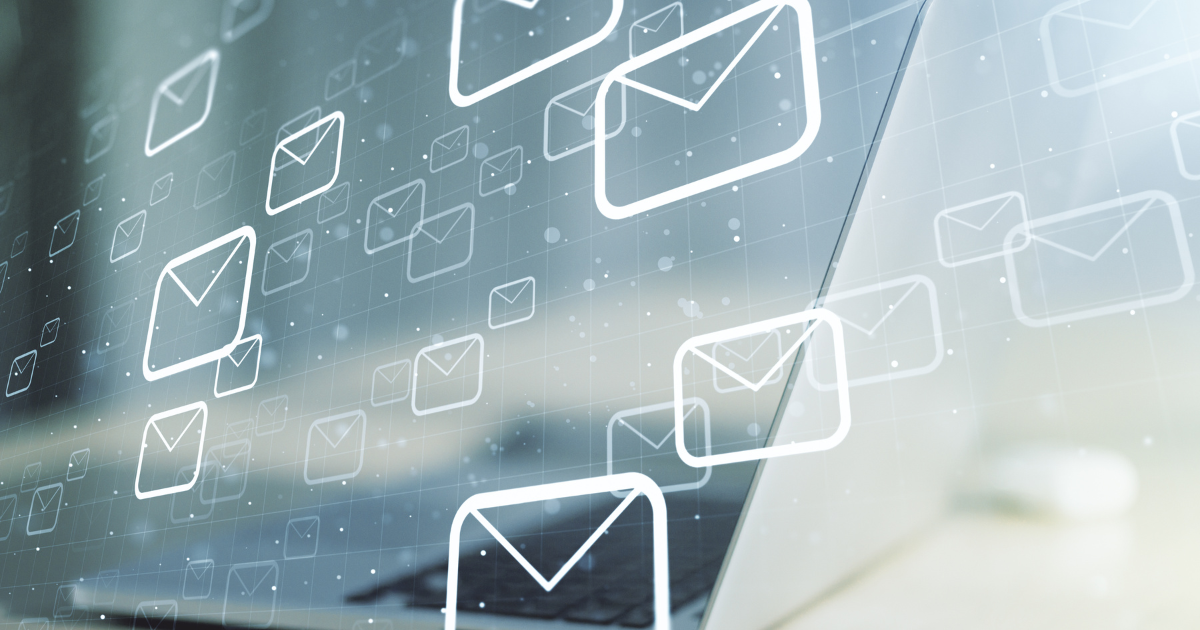
Your author newsletter is an asset for building a loyal readership. It's more than just a sales pitch; it's a platform to connect with fans on a personal level.
Want to keep readers engaged and coming back for more? Let's dive into the world of newsletter topics to spark some inspiration on what to put in a newsletter that will truly captivate your audience.
Key Takeaways
- Focus on value, not just sales. Build trust with personal stories, exclusive content, and industry insights. Offer genuine value to your readers and position yourself as a trusted authority in your genre.
- Engage your audience. Encourage interaction via Q&A, discussions, and early access opportunities. Create a sense of community and make your readers feel valued by actively listening and responding to their feedback.
A. Why Author Newsletters?
There is a multitude of articles on email marketing and how mastering it is essential in building a strong fanbase even before being a published author. We will not go over that.
Recently, there was a post by Jenn dePaula about someone who had started a TikTok account in her name. This led to a discussion on how social media platforms are unreliable foundations for author platforms. Fake accounts and algorithm changes threaten author visibility.
A newsletter, on the other hand, offers stability. Writers' newsletters are their digital sanctuary, a direct line to readers, free from the whims of social media.
By building a loyal email list, you're not just using a marketing tool; you're building a safety net for your author brand.
How to start
Authors think of their newsletter solely as a means to generate interest in their books. While this is indeed the end goal, this should not be the sole focus of your author newsletter.
🔥 Avoid impersonal sales pitches. Subscribers want to hear from you personally. Keep your messages authentic and relevant.
Focus on providing value to your readers. Share personal stories, respond to comments, and create a sense of community. Offer exclusive content or early access to new releases as incentives to subscribe, but formulate it as a call to action or occasional blurb, not as the center focus.
Acknowledge that your following might read more than you could possibly write; therefore, offer them valuable content to be inspired, educated, and entertained.
1. Curate your content
Determine what information your readers want to receive. This might include writing updates, new book releases, author interviews, book recommendations, excerpts, writing tips, or behind-the-scenes glimpses. Experiment with different content formats like blog posts, short stories, or Q&A sessions.
This positions you as a knowledge resource. Curated content can also introduce you to new readers and expand your audience.
2. Create a consistent format
Include a mix of personal updates, writing progress, book promotions, and curated content. Consider creating categories like behind-the-scenes, book corner, or reader spotlight to organize your content. This structure provides a clear framework and builds anticipation.
💡 Building a quality subscriber list requires careful attention to detail.
- Always obtain explicit permission before adding someone to your list, and prioritize building trust through authentic communication.
- Implement a double opt-in system to verify subscriber interest and avoid spam complaints.
- Customize your subscription forms to gather the necessary information without overwhelming potential subscribers.
What you need
Creating a successful author newsletter doesn't have to be overwhelming. When it comes to technicalities, follow these few steps:
1. Choose your email service provider
A dedicated email service provider is important for managing your writer's newsletter. Popular options include ConvertKit, Mailchimp, and Constant Contact. These platforms offer tools to grow your list and send professional emails.
MailerLite is often considered the most budget-friendly option, and it's favored by many authors. Substack caters particularly to writers, journalists, freelancers, and others who might consider charging for their work down the line.
There are other author newsletter models that you can explore further; Jane Friedman presents them in detail in her article here.
- RSS-based Newsletters: Automatically send emails with new blog posts or excerpts whenever your feed updates. This is a free option on platforms like WordPress but with limited customization.
- Paid Subscriptions: Services like Substack let you charge for access to your newsletter. Focus on providing valuable content that justifies the cost.
2. Create a newsletter signup form
Design an attractive signup form to capture reader emails. Integrate the sign-up form directly into your website (header, footer, sidebar) for greater visibility and convenience. Most email service providers offer easy-to-use code for embedding.
Customize the header, text, and requested information to match your brand and audience. While limiting required fields to email and (optional) name often yields the highest sign-up rates, collecting additional data can enhance targeted messaging.
Include an unsubscribe option; this is requested by law for bulk messaging.
3. Create a landing page
A landing page is where subscribers land after signing up. Use it to welcome new subscribers and offer additional value.
Once subscribers reach your landing page, they can claim the promised bonus. While it can boost sign-ups, it might attract subscribers who only want the freebie and unsubscribe later.
💡For content ideas, check out the article on how bonus content can boost your marketing strategy.
4. Build a welcome email sequence
Welcome new subscribers with a series of emails introducing yourself and your writing. This fosters connection and engagement.
5. Decide upon a sending calendar
Choose a day of the week to send your newsletter and stick to it. Remember, more frequent newsletters generally benefit from shorter content.
Consider your target audience when selecting a day. Weekdays might be better for business-oriented content, while weekends could be more suitable for fiction readers.
B. Newsletter Content Ideas
Newsletter content is the heart of your email campaign. It's what keeps subscribers coming back for more. When considering the topics for a newsletter, think about what truly excites you and your audience.
When you look at things to include in a newsletter, focus on delivering a message that strikes all of these pillars – relationship, information, and engagement.
There will always be community members who unsubscribe down the line; focus on those remaining and delivering what they signed up for.
1. Build a strong relationship with your community
Share personal anecdotes and behind-the-scenes glimpses, all in a conversational tone that weaves a sense of intimacy with readers.
Conduct Q&As, encourage feedback, and host online discussions to create a community around your work. Engaging with your readers can lead to deeper connections and loyal subscribers.
Topics for the newsletter:
- Share personal stories about your writing process, challenges, and triumphs.
- Whenever appropriate, include personal milestones and experiences to build trust and authenticity.
- Include glimpses of your daily life as a writer to humanize your author persona.
- Share fun facts about your writing process to pique curiosity.
- Write your thoughts on hobbies, places, or events to showcase your interests and personality.
- Offer insights into your world as an author, such as your writing space or research process [include pictures to create a feeling of friendliness].
- Share lessons learned from writing a book for those who might be inspired to start this journey.
- Discuss your experiences at book events to share insights from the literary world.
2. Provide exclusive content
Offer subscriber-only content, not texts that have already been published on your blog or website, You can also focus your effort on creating content that requires a paid subscription, but make sure this is different from your free newsletter.
In your newsletter, offer first access to new releases to reward loyalty. Exclusive content is a powerful tool for increasing subscriber satisfaction and encouraging word-of-mouth recommendations.
Share writing tips, industry insights, your favorite books, movies, music, or anything else you enjoy.
Topics for the newsletter:
- Include or give more details about deleted scenes, character profiles, or writing exercises to stir interest in a new book, installment, or character.
- Reveal the expanded backstory used to develop a character to enrich reader understanding and deepen their connection to the story.
- Share writing tips, industry insights, and book recommendations.
- Create how-to guides or tutorials related to your genre or craft.
- Interview other authors or feature reader contributions to expand your newsletter's content
- Repurpose content from speaking engagements that might spark curiosity in your audience.
- Share book research and findings to inform readers about the world-building process and provide additional context.
- Note outside news or events related to your book's topic to connect your work to current affairs.
- Pass on endorsements, quotes, or discussions about your book to build credibility and generate interest.
- Discuss social themes associated with your book to promote thought-provoking conversations.
- Include brief book reviews of others’ books to expand your readers' horizons.
- Tell what you’re currently reading, and list your favorite books in your genre.
- Ask what subscribers are reading and gather the topics they want to read about.
- Request and publish subscribers’ nominations of the best book in your genre to involve your readers.
3. Boost engagement
Use high-quality images, graphics, and videos to enhance visual interest. Experiment with layout designs and use eye-catching headlines to capture attention.
Make your newsletter visually attractive without overdoing it. Focus on readability. With countless newsletters fighting for attention, readers are inundated with content. To stand out, craft unique subject lines for each issue, making your newsletter instantly recognizable.
Prioritize scannability by using subheadings, lists, and bold text to guide readers quickly to the information they seek. For longer newsletters, consider adding a table of contents. Ensure important links are prominently displayed twice to maximize click-throughs.
Keeping your newsletter engaging as well as informative requires balancing newsletter content with:
- Teasers and unedited bits of writing, work-in-progress covers, and blurbs.
- FAQ corners
- Make sure you share your book-related news and pre-order links directly with your newsletter subscribers before announcing them on social media.
- Offer exclusive giveaways, signed books, merchandise, or gift cards.
- Provide access to advanced reader copies (ARCs), opportunities to join your street team, or participate in cover reveals.
Read more newsletter content ideas here.
Author Newsletter Examples
1. Katee Robert Newsletter
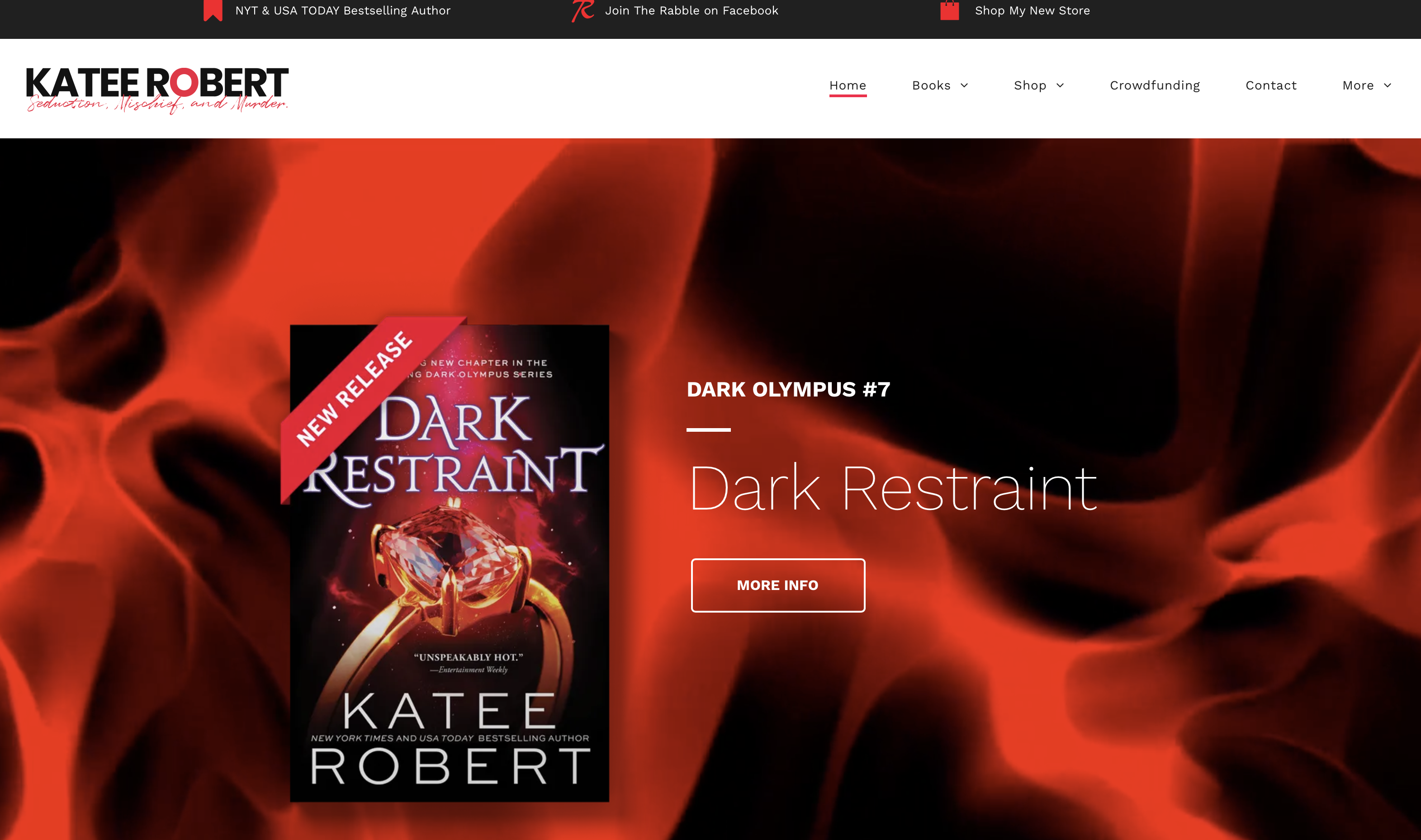
Katee Robert is a New York Times and USA Today bestselling author celebrated for their undeniably scorching romance novels. Entertainment Weekly has hailed their work as unspeakably hot. With over two million copies sold, their books have captivated readers worldwide.
Subscribe to their author newsletter here.
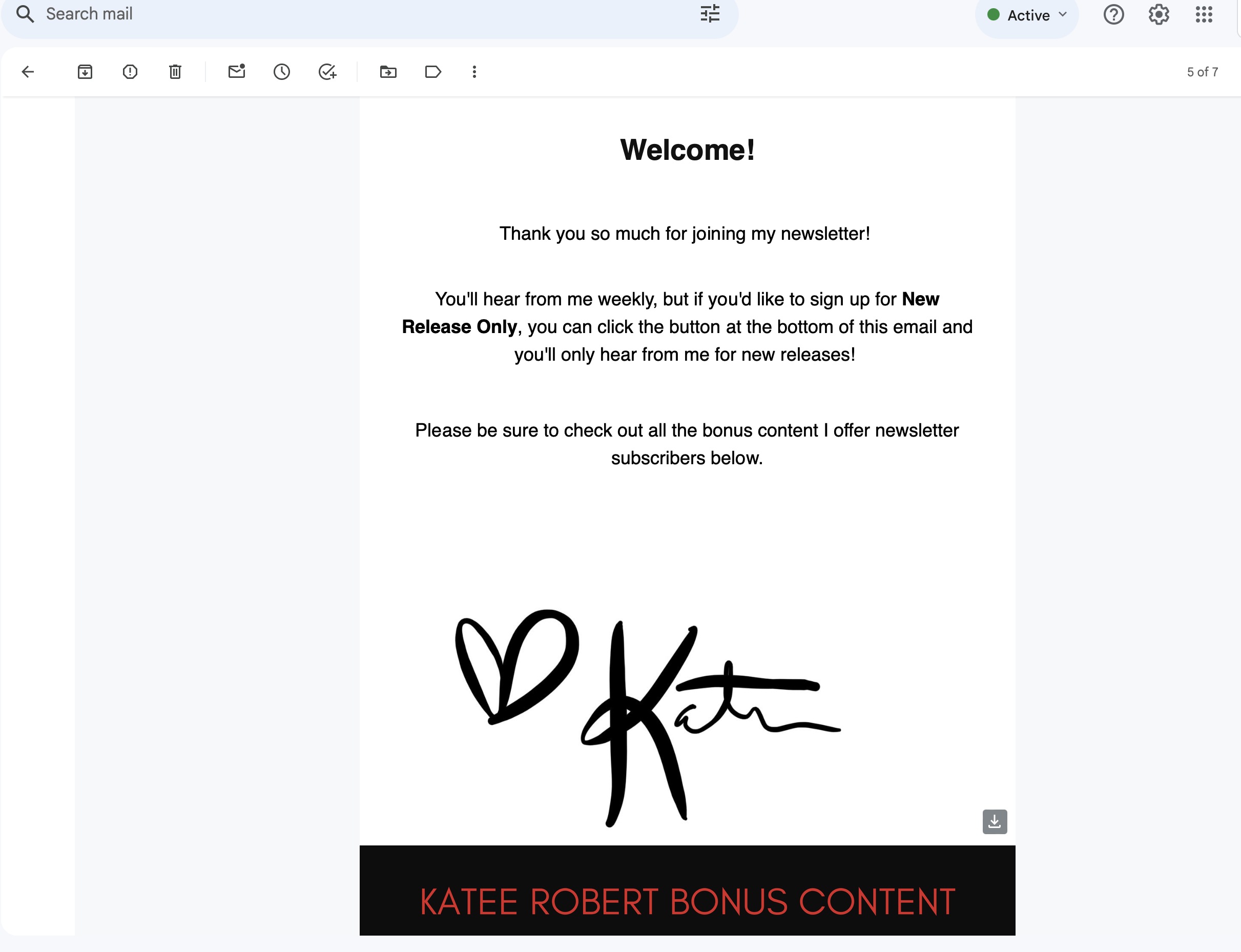
2. The Crow's Nest
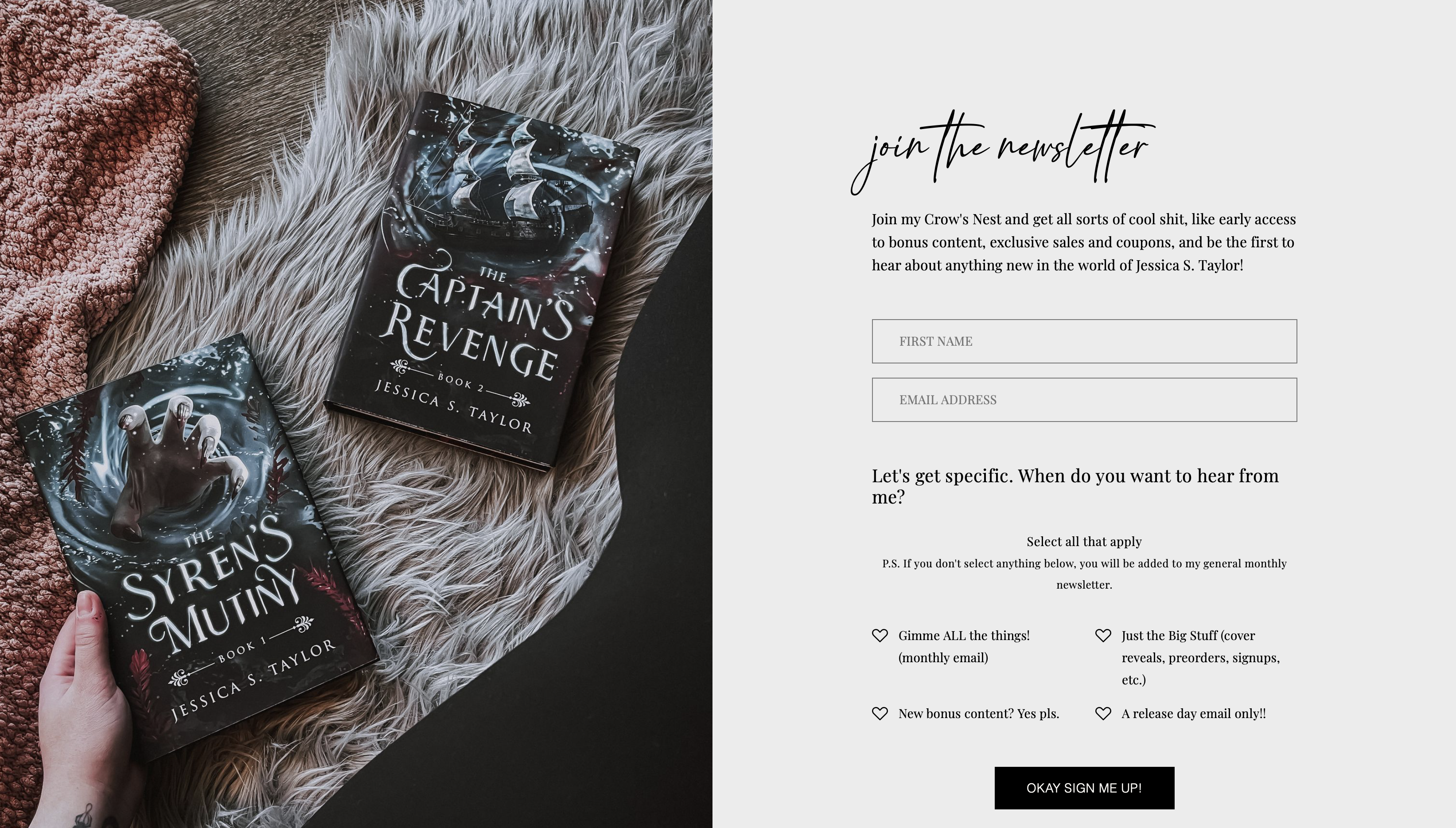
Jessica S. Taylor is a mythology enthusiast and author of the dark fantasy romance, The Seas of Caladhan. As a child, she was a frequent library patron, devouring books voraciously. When her reading appetite couldn't be satisfied, she turned to writing her own stories.
Her author newsletter promises at least a monthly delivery of cool and gruesome.
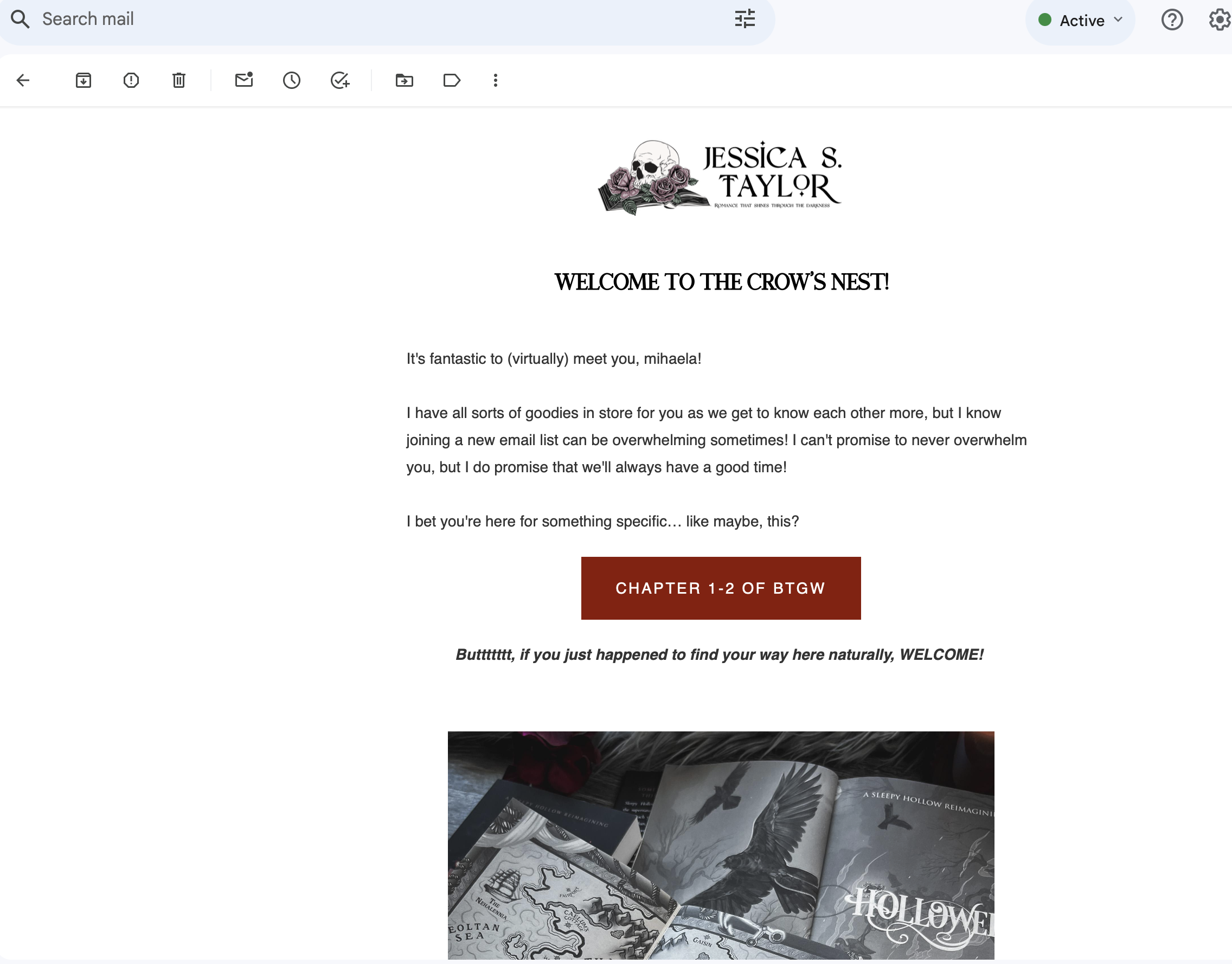
Two days later, this newsletter arrived.
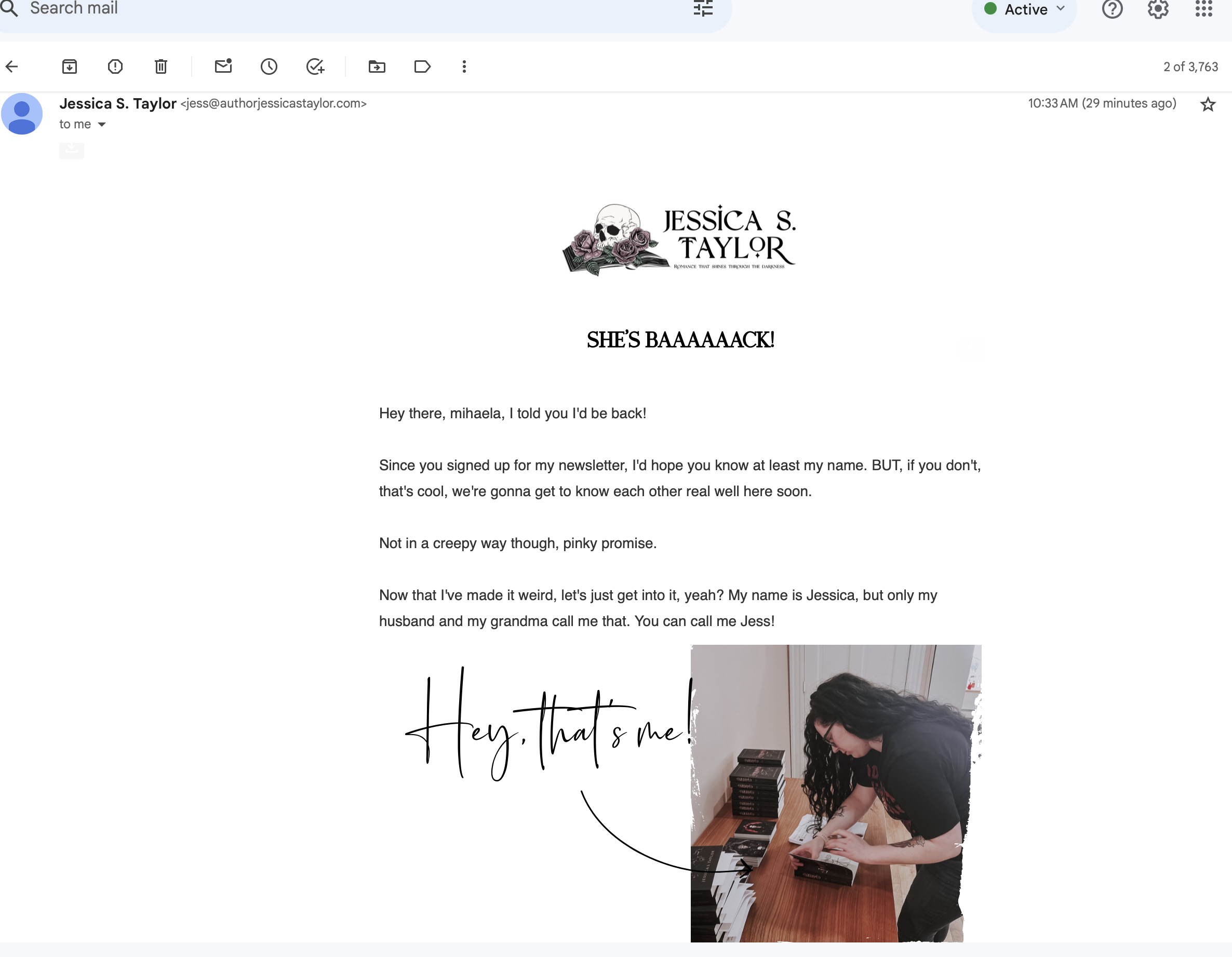
3. Vanessa Rasanen
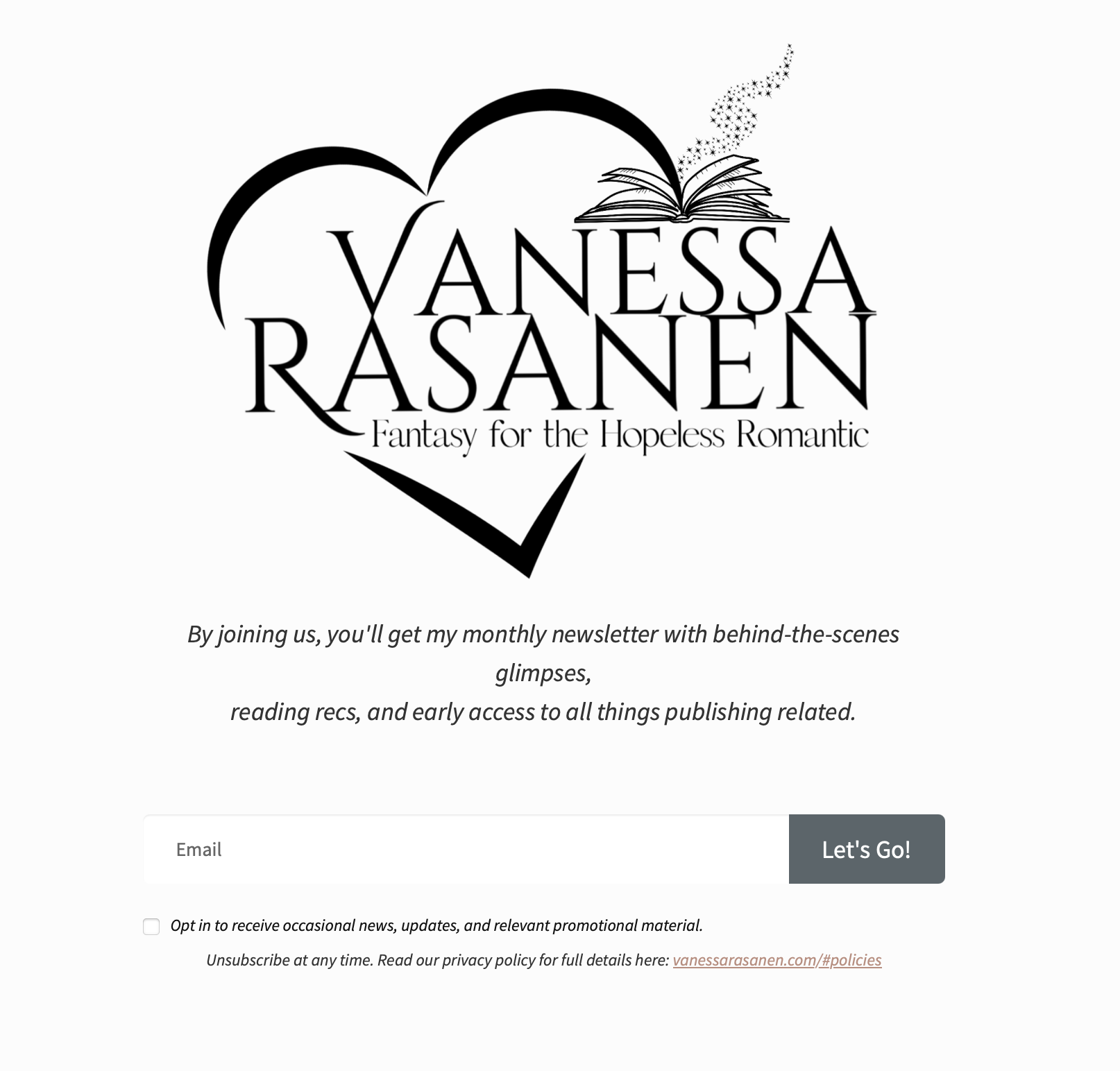
Vanessa Rasanen's author newsletter for the hopelessly romantic offers subscribers exclusive access to behind-the-scenes glimpses of her writing world, personalized reading recommendations, and early updates on all things publishing.
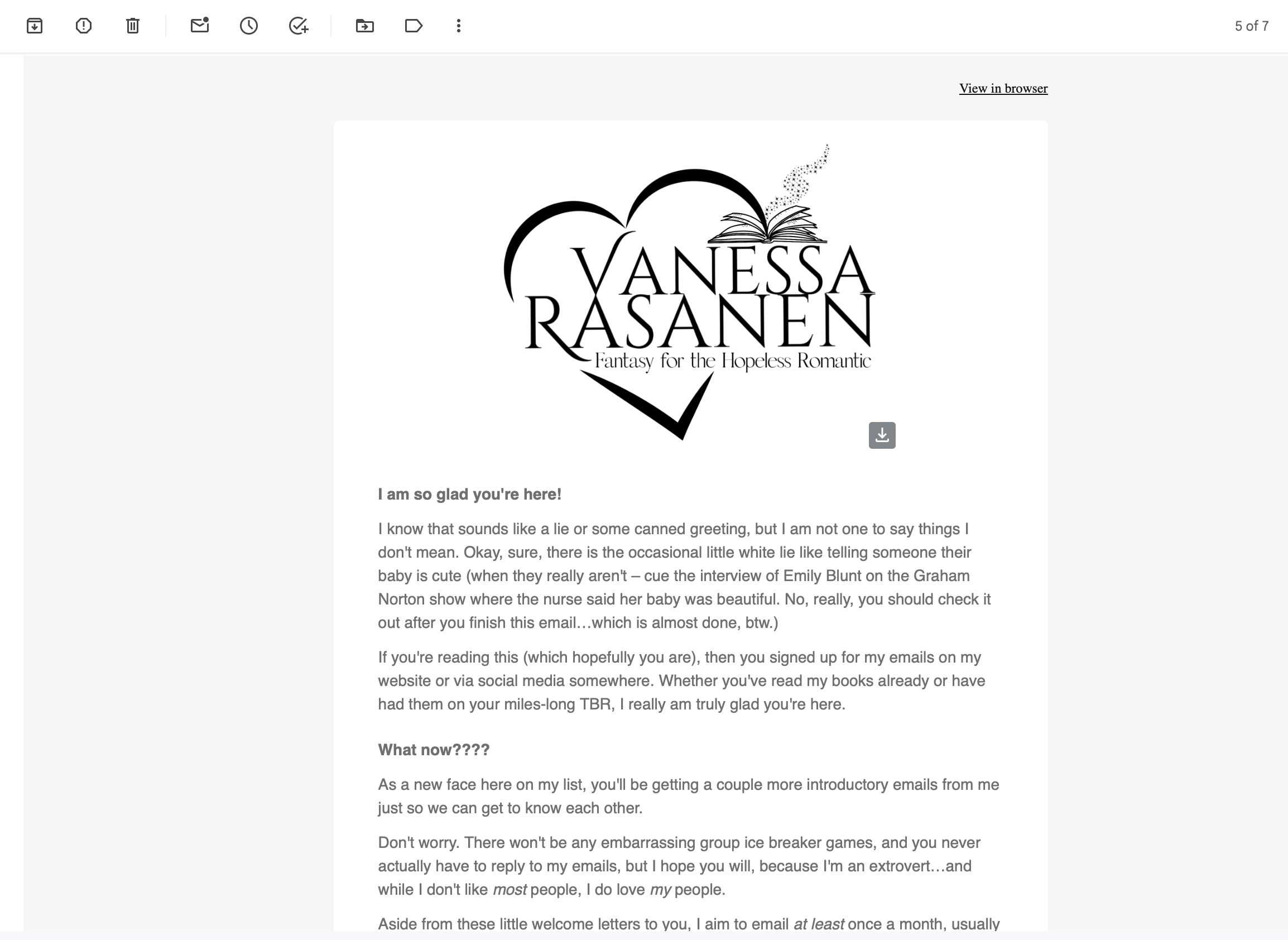
Next, this newsletter a couple of days later:
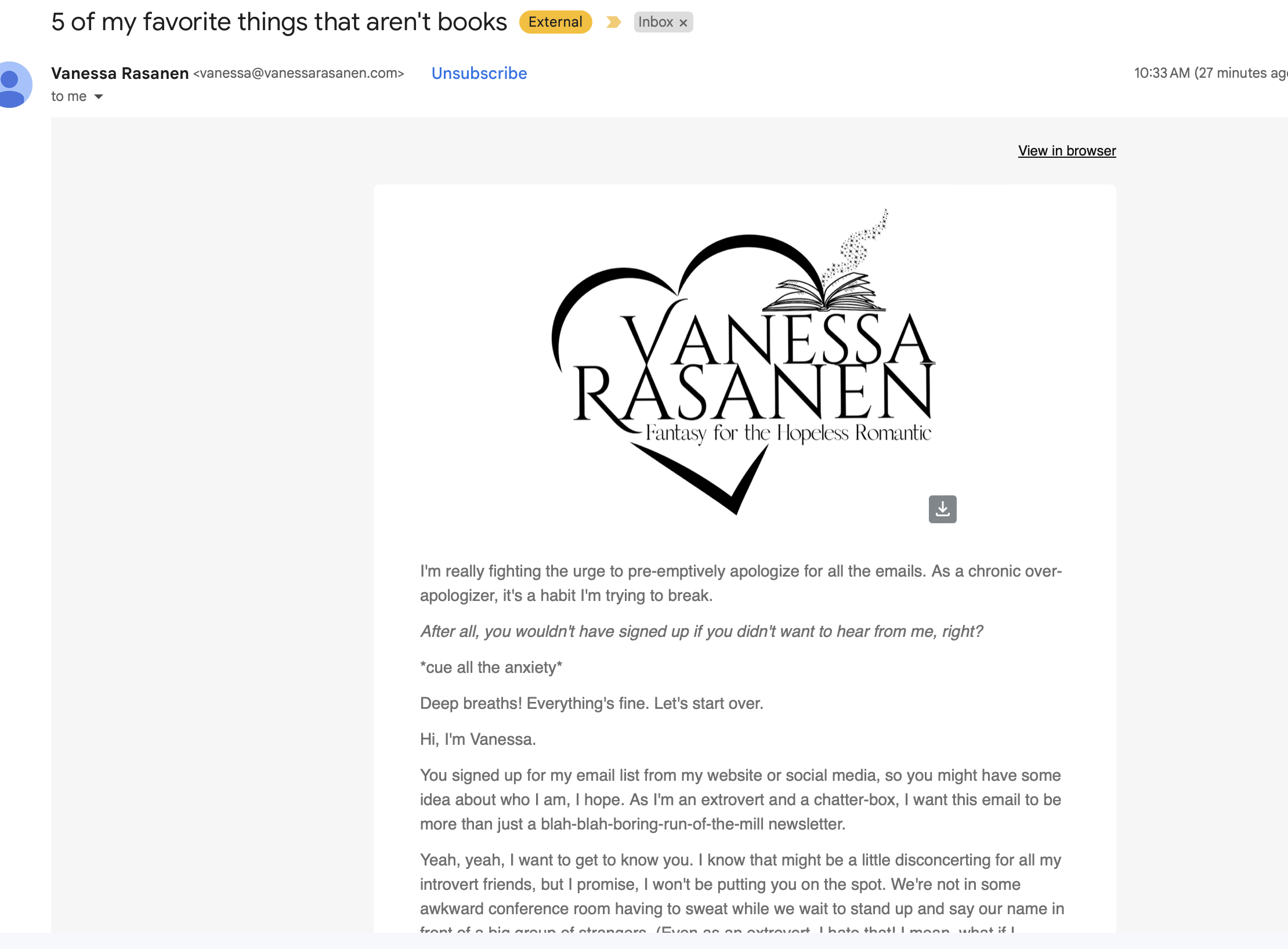
4. Monica Leonelle
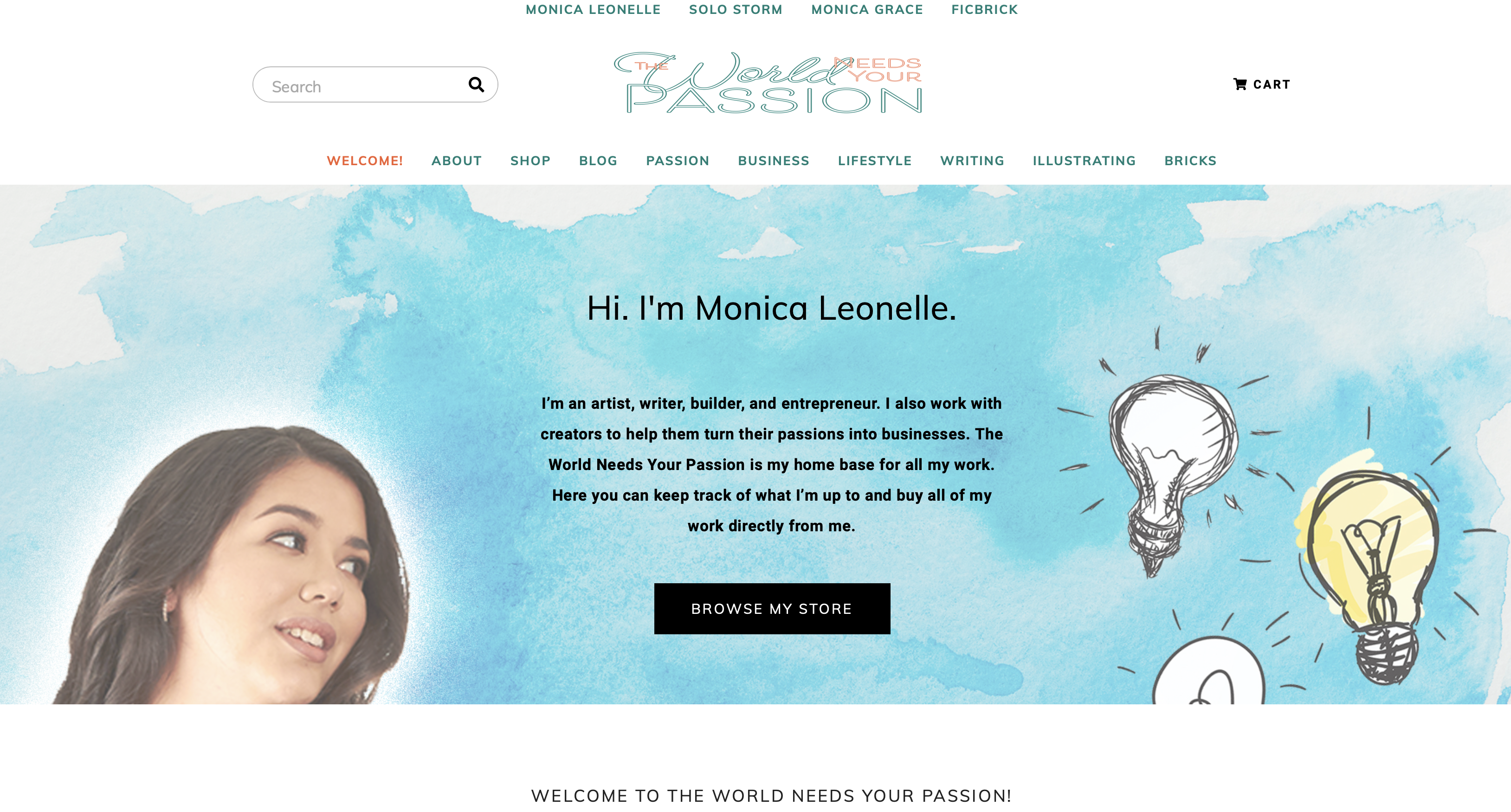
In her newsletter, she shares their journey, advocating for passion as a catalyst for personal growth and a better world.
This is her first email:
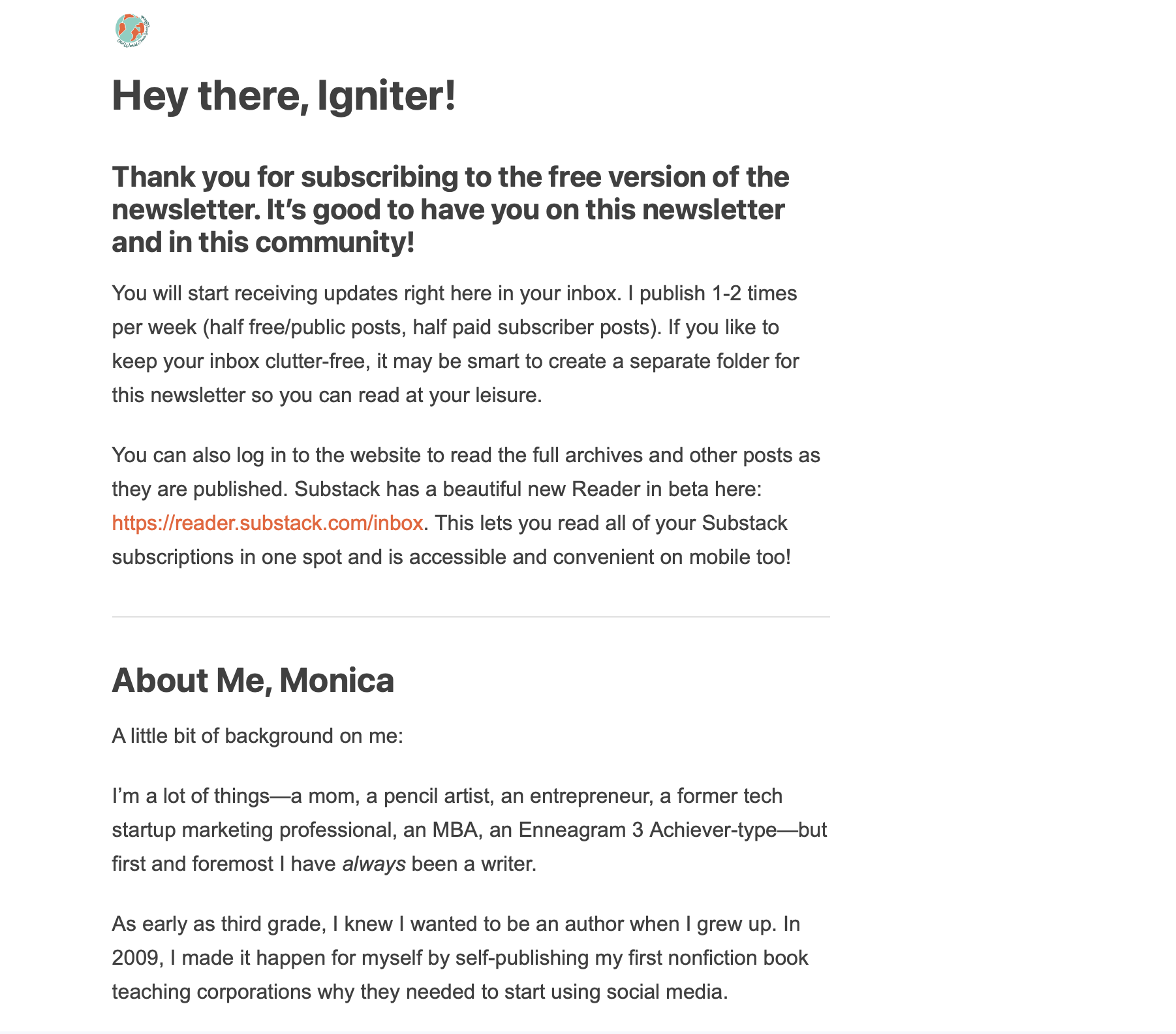
And then:
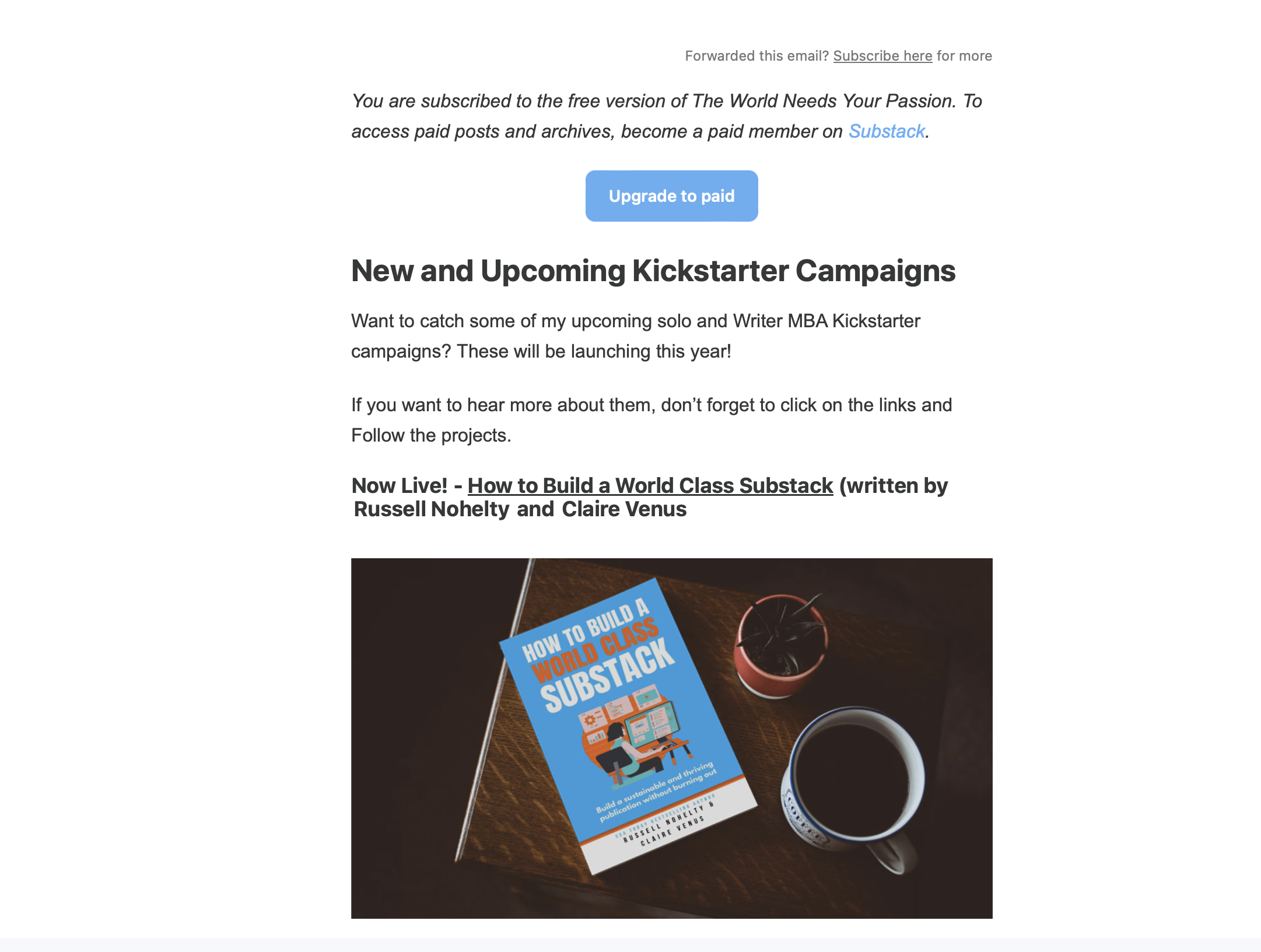
5. Laura's E-letter for Educators
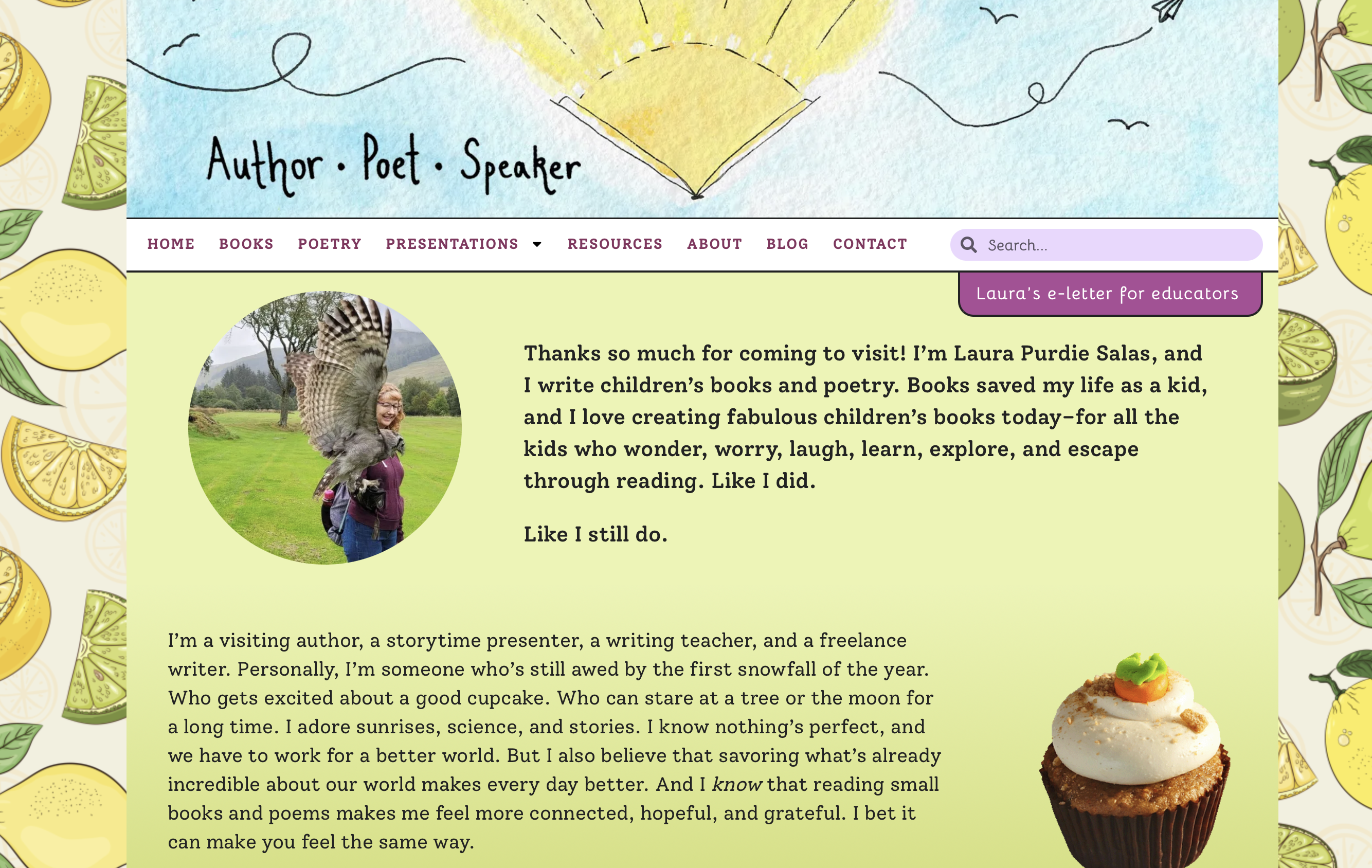
Laura's author newsletter is dedicated to educators and offers a monthly collection of poems, classroom ideas, and resources. Subscribers can expect to receive practical tools and inspiration for their teaching.
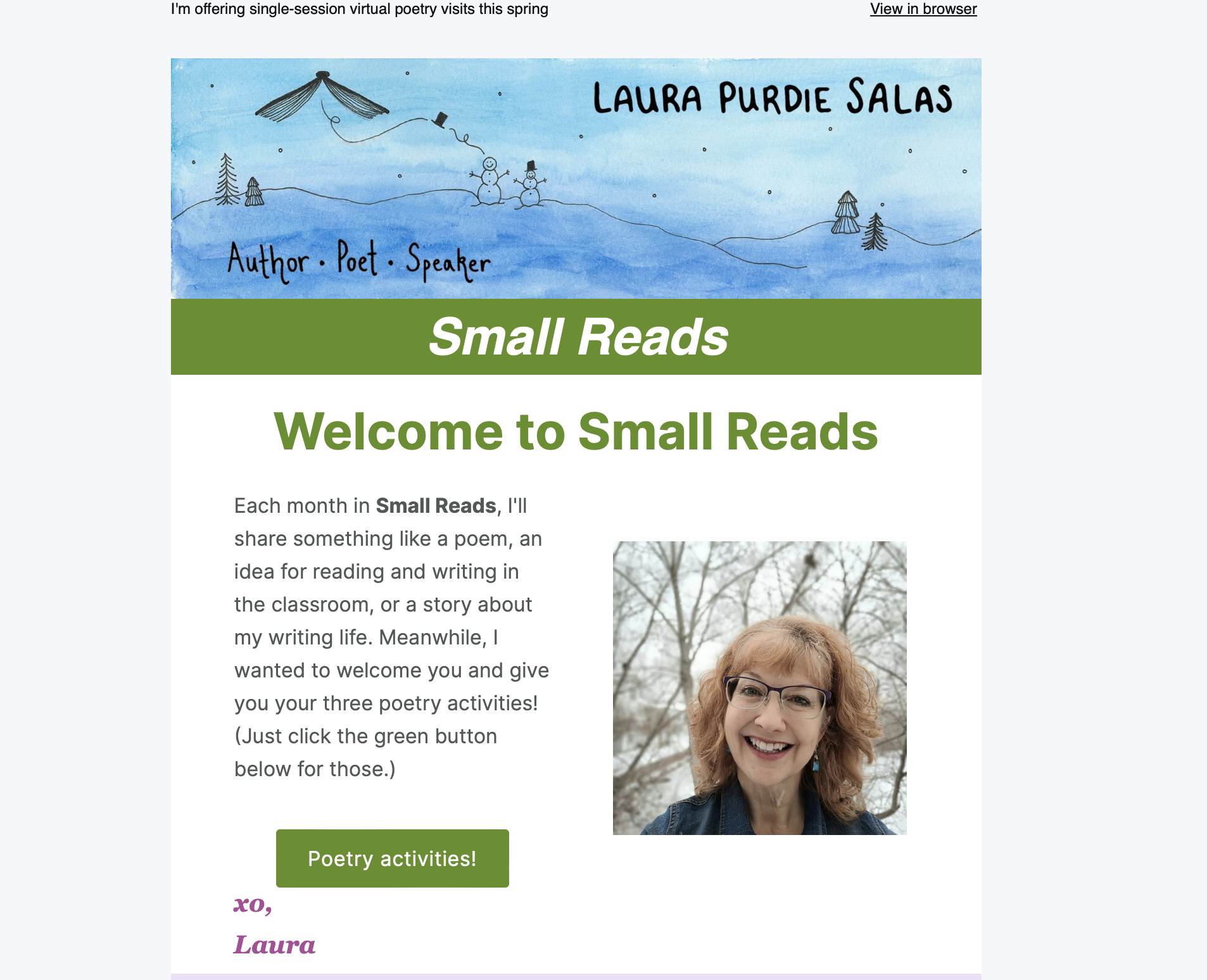
Conclusion
A well-executed author newsletter is a game-changer. Share personal insights, offer exclusive content, and foster a sense of community to build your loyal following. This, in turn, gets you the support to set new author goals.